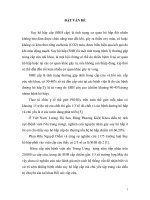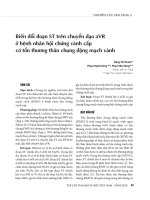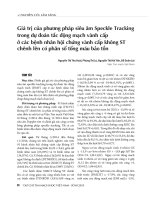Xử trí ban đầu hội chứng vành cấp
Bạn đang xem bản rút gọn của tài liệu. Xem và tải ngay bản đầy đủ của tài liệu tại đây (1.85 MB, 40 trang )
XỬ TRÍ BAN ĐẦU
HỘI CHỨNG MẠCH VÀNH CẤP
TS.BS. Nguyễn Quốc Thái
VIỆN TIM MẠCH VIỆT NAM
Hospitalizations in the U.S. Due to Acute
Coronary Syndromes (ACS)
Acute Coronary
Syndromes*
1.57 Million Hospital Admissions - ACS
UA/NSTEMI†
STEMI
1.24 million
.33 million
Admissions per year
Admissions per year
Heart Disease and Stroke Statistics – 2007 Update. Circulation 2007; 115:69-171.
*Primary and secondary diagnoses. †About 0.57 million NSTEMI and 0.67 million UA.
Tiến triển của mảng xơ vữa trong HCMVC
Onset of NSTE-ACS
Hospital Management
-Initial recognition and management in the
ED by first responders or ED personnel
-Risk stratification
-Immediate management
-Medication
-Conservative versus invasive strategy
-Special groups
-Preparation for discharge
Management Prior to
NSTE-ACS
2014 AHA/ACC Guideline for
the Management of Patients
With Non–ST-Elevation
Acute
2014 AHA/ACC Guideline for the Management of Patients With
Non–ST-Elevation Acute Coronary Syndromes
Coronary Syndromes
Secondary Prevention/
Long-Term Management
Acute Coronary Syndromes
Presentation
Ischemic Discomfort
ACS
Working Dx
ECG
No ST Elevation
ST Elevation
NSTE-ACS
Cardiac Biomarker
UA
Unstable Angina
Final Dx
NSTEMI *
STEMI *
Myocardial Infarction
NQMI
QwMI
2014 AHA/ACC Guideline for the Management of Patients
With Non–ST-Elevation Acute Coronary Syndromes
Noncardiac
Etiologies
Tỷ lệ tử vong sau HCMVC liên tục tăng theo
thời gian
7
Tỷ lệ tử vong sau xuất viện 16 -180 ngày (sổ bộ GRACE) *
ST không chênh lên
Tỷ lệ tử vong tích lũy(%)
6
ST chênh lên
5
4
Không xác định
3
2
1
0
26
46
66
86
106
126
146
Ngày từ khi nhập viện
Fox KA, et a l . Eur Heart J 2010;31:2755−2764; Va ts pace. Ava ilable a t yndrome/ (accessed November 2013).
166
186
Algorithm for Management of Patients With Definite or Likely NSTE-ACS
NSTE-ACS:
Definite or Likely
Ischemia-Guided Strategy
Early Invasive Strategy
Initiate DAPT and Anticoagulant Therapy
1. ASA (Class I; LOE: A)
Initiate DAPT and Anticoagulant Therapy
1. ASA (Class I; LOE: A)
2. P2Y12 inhibitor (in addition to ASA) (Class I; LOE: B) :
· Clopidogrel or
· Ticagrelor
2. P2Y12 inhibitor (in addition to ASA) (Class I; LOE: B):
· Clopidogrel or
· Ticagrelor
3. Anticoagulant:
· UFH (Class I; LOE: B) or
· Enoxaparin (Class I; LOE: A) or
· Fondaparinux (Class I; LOE: B)
3. Anticoagulant:
· UFH (Class I; LOE: B) or
· Enoxaparin (Class I; LOE: A) or
· Fondaparinux† (Class I; LOE: B) or
· Bivalirudin (Class I; LOE: B)
Can consider GPI in addition to ASA and P2Y12 inhibitor
in high-risk (e.g., troponin positive) pts
(Class IIb; LOE: B)
· Eptifibatide
· Tirofiban
Medical therapy
chosen based on cath
findings
Therapy
Effective
Therapy
Ineffective
2014 AHA/ACC Guideline for the Management of Patients With Non–STElevation Acute Coronary Syndromes
Therapy
Effective
Therapy
Ineffective
PCI With Stenting
Initiate/continue antiplatelet and anticoagulant
therapy
1. ASA (Class I; LOE: B)
CABG
Initiate/continue ASA therapy and
discontinue P2Y12 and/or GPI therapy
1. ASA (Class I; LOE: B)
2. P2Y12 Inhibitor (in addition to ASA) :
· Clopidogrel (Class I; LOE: B) or
· Prasugrel (Class I; LOE: B) or
· Ticagrelor (Class I; LOE: B)
2. Discontinue clopidogrel/ticagrelor 5 d
before, and prasugrel at least 7 d before
elective CABG
3. GPI (if not treated with bivalirudin at time of PCI)
· High-risk features, not adequately pretreated
with clopidogrel (Class I; LOE: A)
· High-risk features adequately pretreated with
clopidogrel (Class IIa; LOE: B)
4. Anticoagulant:
· Enoxaparin (Class I; LOE: A) or
· Bivalirudin (Class I; LOE: B) or
· Fondaparinux† as the sole anticoagulant (Class
III: Harm; LOE: B) or
· UFH (Class I; LOE: B)
3. Discontinue clopidogrel/ticagrelor up to
24 h before urgent CABG (Class I; LOE: B).
May perform urgent CABG <5 d after
clopidogrel/ticagrelor and <7 d after
prasugrel discontinued
4. Discontinue eptifibatide/tirofiban at
least 2-4 h before, and abciximab ≥12 h
before CABG (Class I; LOE: B)
Late Hospital/Posthospital Care
1. ASA indefinitely (Class I; LOE: A)
2. P2Y12 inhibitor (clopidogrel or
ticagrelor), in addition to ASA, up
to 12 mo if medically treated
(Class I; LOE: B)
3. P2Y12 inhibitor (clopidogrel,
prasugrel, or ticagrelor), in
addition to ASA, at least 12 mo if
treated with coronary stenting
(Class I; LOE: B)
†In
patients who have been treated with fondaparinux (as upfront therapy) who are
undergoing PCI, an additional anticoagulant with anti-IIa activity should be administered at
the time of PCI because of the risk of catheter thrombosis.
MEDICAL TREATMENT
• Bed rest
• Continuous ECG monitoring
• Ambulation only if
No recurrence of ischemia (symptoms or ECG changes)
Does not develop an elevation of a biomarker of necrosis for
12–24 h
ANTI-ISCHEMIC
ANTITHROMBOTIC
NSTE-ACS
LIỆU PHÁP ĐIỀU TRỊ
CHỐNG THIẾU
MÁU CƠ TIM
KHÁNG ĐÔNG
Tiêu sợi huyết
Chống ngưng tập
tiểu cầu
Chống đông
NSTE-ACS
Giảm đau và chống thiếu máu cơ tim
Xử trí sớm tại bệnh viện
Liệu pháp điều trị chuẩn
Oxygen
Recommendation
Supplemental oxygen should be administered to patients with
NSTE-ACS with arterial oxygen saturation less than 90%,
respiratory distress, or other high-risk features of hypoxemia.
2014 AHA/ACC Guideline for the Management of Patients
With Non–ST-Elevation Acute Coronary Syndromes
COR
LOE
I
C
Anti-Ischemic and Analgesic Medications:
Nitrates
Recommendations
COR
Patients with NSTE-ACS with continuing ischemic pain
should receive sublingual nitroglycerin (0.3 mg to 0.4 mg)
every 5 minutes for up to 3 doses, after which an
I
assessment should be made about the need for intravenous
nitroglycerin if not contraindicated.
Intravenous nitroglycerin is indicated for patients with
NSTE-ACS for the treatment of persistent ischemia, HF, or
I
hypertension.
Nitrates should not be administered to patients with NSTEACS who recently received a phosphodiesterase inhibitor,
III:
especially within 24 hours of sildenafil or vardenafil, or
Harm
within 48 hours of tadalafil.
2014 AHA/ACC Guideline for the Management of Patients
With Non–ST-Elevation Acute Coronary Syndromes
LOE
C
B
B
Anti-Ischemic and Analgesic Medications:
Analgesic Therapy
Recommendations
In the absence of contraindications, it may be reasonable to
administer morphine sulfate intravenously to patients with NSTEACS if there is continued ischemic chest pain despite treatment
with maximally tolerated anti-ischemic medications.
Nonsteroidal anti-inflammatory drugs (NSAIDs) (except aspirin)
should not be initiated and should be discontinued during
hospitalization for NSTE-ACS because of the increased risk of
MACE associated with their use.
2014 AHA/ACC Guideline for the Management of Patients
With Non–ST-Elevation Acute Coronary Syndromes
COR
LOE
IIb
B
III:
Harm
B
Anti-Ischemic and Analgesic Medications:
Beta-Adrenergic Blockers
Recommendations
Oral beta-blocker therapy should be initiated within the first
24 hours in patients who do not have any of the following: 1)
signs of HF, 2) evidence of low-output state, 3) increased
risk for cardiogenic shock, or 4) other contraindications to
beta blockade (e.g., PR interval >0.24 second, second- or
third-degree heart block without a cardiac pacemaker,
active asthma, or reactive airway disease).
In patients with concomitant NSTE-ACS, stabilized HF, and
reduced systolic function, it is recommended to continue
beta-blocker therapy with 1 of the 3 drugs proven to reduce
mortality in patients with HF: sustained-release metoprolol
succinate, carvedilol, or bisoprolol.
2014 AHA/ACC Guideline for the Management of Patients
With Non–ST-Elevation Acute Coronary Syndromes
COR
LOE
I
A
I
C
Anti-Ischemic and Analgesic Medications:
Beta-Adrenergic Blockers (cont’d)
Recommendations
Patients with documented contraindications to beta blockers in
the first 24 hours of NSTE-ACS should be re-evaluated to
determine their subsequent eligibility.
It is reasonable to continue beta-blocker therapy in patients with
normal LV function with NSTE-ACS.
Administration of intravenous beta blockers is potentially harmful
in patients with NSTE-ACS who have risk factors for shock.
2014 AHA/ACC Guideline for the Management of Patients
With Non–ST-Elevation Acute Coronary Syndromes
COR
LOE
I
C
IIa
C
III:
Harm
B
Anti-Ischemic and Analgesic Medications:
Calcium Channel Blockers
Recommendations
COR
In patients with NSTE-ACS, continuing or frequently
recurring ischemia, and a contraindication to beta blockers,
a nondihydropyridine calcium channel blocker (CCB) (e.g.,
verapamil or diltiazem) should be given as initial therapy in
I
the absence of clinically significant LV dysfunction,
increased risk for cardiogenic shock, PR interval greater
than 0.24 second, or second- or third-degree atrioventricular
block without a cardiac pacemaker.
Oral nondihydropyridine calcium antagonists are
recommended in patients with NSTE-ACS who have
I
recurrent ischemia in the absence of contraindications, after
appropriate use of beta blockers and nitrates.
2014 AHA/ACC Guideline for the Management of Patients
With Non–ST-Elevation Acute Coronary Syndromes
LOE
B
C
Anti-Ischemic and Analgesic Medications:
Calcium Channel Blockers (cont’d)
Recommendations
CCBs† are recommended for ischemic symptoms when
beta blockers are not successful, are contraindicated, or
cause unacceptable side effects.
Long-acting CCBs and nitrates are recommended in
patients with coronary artery spasm.
Immediate-release nifedipine should not be administered to
patients with NSTE-ACS in the absence of beta-blocker
therapy.
†Short-acting
COR
LOE
I
C
I
C
III:
Harm
B
dihydropyridine calcium channel antagonists should be avoided.
2014 AHA/ACC Guideline for the Management of Patients
With Non–ST-Elevation Acute Coronary Syndromes
Anti-Ischemic and Analgesic Medications:
Cholesterol Management
Recommendations
High-intensity statin therapy should be initiated or continued in
all patients with NSTE-ACS and no contraindications to its use.
It is reasonable to obtain a fasting lipid profile in patients with
NSTE-ACS, preferably within 24 hours of presentation.
2014 AHA/ACC Guideline for the Management of Patients
With Non–ST-Elevation Acute Coronary Syndromes
COR
LOE
I
A
IIa
C
Inhibitors of Renin-Angiotensin-Aldosterone System
Recommendations
ACE inhibitors should be started and continued indefinitely
in all patients with LVEF less than 0.40 and in those with
hypertension, diabetes mellitus, or stable CKD (Section
7.6), unless contraindicated.
ARBs are recommended in patients with HF or MI with
LVEF less than 0.40 who are ACE inhibitor intolerant.
Aldosterone blockade is recommended in patients post–MI
without significant renal dysfunction (creatinine >2.5 mg/dL
in men or >2.0 mg/dL in women) or hyperkalemia (K >5.0
mEq/L) who are receiving therapeutic doses of ACE
inhibitor and beta blocker and have a LVEF 0.40 or less,
diabetes mellitus, or HF.
2014 AHA/ACC Guideline for the Management of Patients
With Non–ST-Elevation Acute Coronary Syndromes
COR
LOE
I
A
I
A
I
A
Inhibitors of Renin-Angiotensin-Aldosterone System (cont’d)
Recommendations
ARBs are reasonable in other patients with cardiac or other
vascular disease who are ACE inhibitor intolerant.
ACE inhibitors may be reasonable in all other patients with
cardiac or other vascular disease.
2014 AHA/ACC Guideline for the Management of Patients
With Non–ST-Elevation Acute Coronary Syndromes
COR
LOE
IIa
B
IIb
B
TIMI Risk Score* for NSTE-ACS
TIMI Risk
Score
All-Cause Mortality, New or Recurrent MI, or
Severe Recurrent Ischemia Requiring Urgent
Revascularization Through 14 d After
Randomization, %
0–1
2
3
4
5
6–7
4.7
8.3
13.2
19.9
26.2
40.9
*The TIMI risk score is determined by the sum of the presence of 7
variables at admission; 1 point is given for each of the following variables:
≥65 y of age; ≥3 risk factors for CAD; prior coronary stenosis ≥50%; ST
deviation on ECG; ≥2 anginal events in prior 24 h; use of aspirin in prior 7
d; and elevated cardiac biomarkers.
2014 AHA/ACC Guideline for the Management of Patients
With Non–ST-Elevation Acute Coronary Syndromes
GRACE Risk Model Nomogram
To convert serum creatinine level to micromoles per liter, multiply by 88.4.
2014 AHA/ACC Guideline for the Management of Patients
With Non–ST-Elevation Acute Coronary Syndromes









